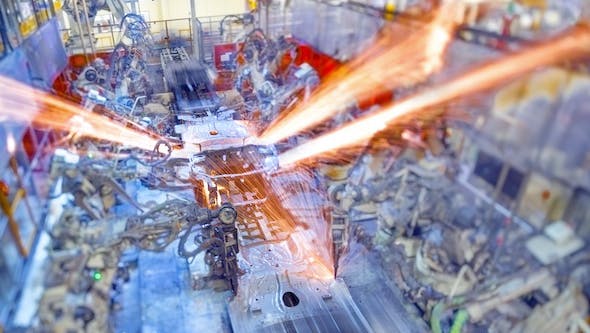Want to know your Genba from your Kanban, and your Muda from your Nemawashi? This glossary explains many of the terms and phrases used within the efficient Toyota Production System.
In multicultural societies, it is common for words from different languages to be adopted as part of everyday lexicon, for it can help people efficiently explain and more readily understand things that might otherwise be alien to them. Numerous Japanese words have crossed over into the English language, so most people will instantly know what familiar words such as bonsai, karaoke, origami, tycoon, karate and futon mean.
Japanese car manufacturing, the modern methods of which were pioneered by Toyota, has its own specific words and terms to describe various processes, methods and philosophies. These have all been adopted into the vocabulary of the Toyota workforce at Burnaston, but they are not necessarily familiar to the outside world.
In this glossary we therefore aim to list and describe some of these words and phrases, in order that we can all have a better understanding of the efficient Toyota Production System, which has subsequently been adopted by all major car manufacturers since its inception.
Andon (English: Paper lantern)
Originating from the word for a paper lantern, it is a term that refers to an illuminated signal notifying others of a problem within the quality-control or production streams. Activation of the alert — usually by a pull-chord or button — automatically halts production so that a solution can be found. The warning lights are incorporated into an easily visible, overhead signboard, which also identifies the area or specific workstation that has the problem. The frequency and nature of these occasional issues are analysed as part of Toyota’s programme of continual improvement.
Genba (English: The actual place, the place where the real work is done)
The factory floor or manufacturing floor; often an open-plan environment where each individual’s work and actions are visible to others. This visibility is exploited in order for third-parties — usually management or section leaders — to conduct regular Genba Walks in order to identify areas where potential improvements might be made, and to better understand the workload of each associate. Walks around the frontline environment of the Genba also ensure that the production system is correctly adhered to.
Genchi Genbutsu (English: Go and see for yourself)
Closely related to the need to walk the Genba, this key principle suggests that to truly understand a situation you need to visit in person. The Toyota Production System requires a high level of management presence on the factory floor, so that if a problem exists in this area it should be first of all correctly understood before being solved. The nature of the phrase is less about the physical act of visiting a site but more to do with a personal understanding of the full implications of any action within an environment as a whole.
Hansei (English: Self-reflection)
To recognise mistakes and take appropriate action to avoid re-occurrence. Even if a task is completed successfully, Toyota recognises the need for a hansei-kai, or reflection meeting; a process that helps to identify failures experienced along the way and create clear plans for future efforts. An inability to identify issues is usually seen as an indication that you did not stretch to meet or exceed expectations, that you were not sufficiently critical or objective in your analysis, or that you lack modesty and humility. Within the Hansei process, no problem is itself a problem.
Heijunka (English: Production smoothing)
A vital technique for reducing waste and improving production efficiency by leveling fluctuations in performance within the assembly line. Fluctuation normally occurs through either customer demand or within production itself. The Toyota Production System uses Heijunka to solve the former by assembling a mix of models within each batch, and ensuring that there is an inventory of product proportional to the variability in demand. Furthermore, the disruption of production flow is minimised by making sure that components are sequenced to be available in the right quantity and at the right time, while changeover periods for vital processes such as die changes within the steel presses are as short as possible; often in as little as three minutes.
Jidoka (English: Autonomation — automation with human intelligence)
A cost-effective quality control process that combines automation with a human’s ability to quickly detect abnormalities, interrupt production, and then correct them before resuming. Employing Jidoka principles throughout the production process is a vital element of the Toyota Production System, forcing imperfections to be immediately addressed by self-inspecting workers and thereby reducing the amount of work added to a defective product. Some autonomated machines can also function in the detection process, allowing human operatives to only be engaged when alerted to a problem. Full application of Jidoka means that the process which created any issue is subsequently evaluated to remove the possibility of re-occurrence.
Just-In-Time (JIT)
A method that minimises the generation, purchasing or holding of component parts as stock items prior to full assembly line production. The primary objectives of JIT are to save warehouse space and unnecessary cost-carrying and to improve efficiency, which means organising the delivery of component parts to individual work stations just before they are physically required. To apply this flow efficiently means relying on ordering signals from Kanban boards or by forecasting parts usage ahead of time, though this latter method requires production numbers to remain stable. Use of JIT within the Toyota Production System means that individual cars can be built to order and that every component has to fit perfectly first time because there are no alternatives available. It is therefore impossible to hide pre-existing manufacturing issues; they have to be addressed immediately.
Kaizen (English: Continuous improvement)
Literally ‘good change’, the word now refers to the culture and philosophy of continuously improving any department or functional process, thereby increasing productivity, quality and efficiency. Within the Toyota Production System, Kaizen humanises the workplace, empowering individual members to identify areas for improvement and suggest practical solutions. The focused activity surrounding this solution is often referred to as a kaizen blitz, while it is the responsibility of each member to adopt the improved standardised procedure and eliminate waste from within the local environment.
Kanban (English: Signboard)
Though literally translated as ‘signboard’, the Toyota-developed method has become known as a clear, sign-based scheduling system triggering the logistical chain of production and maintaining it at an optimal level. Kanban is the quick-response system through which Just-In-Time production is achieved, harmonising inventory levels with actual consumption. Toyota has six rules for the effective application of Kanban: 1) Never pass on defective products; 2) Take only what is needed; 3) Produce the exact quantity required; 4) Level the production; 5) Fine-tune production; and 6) Stabilise and rationalise the process.
Manufacturing Supermarket
A replenishment process which ensures that all manufacturing components ordered from outside suppliers are available to be loaded and delivered in one consignment. Derived from the system used by retail supermarkets, it levels the occasional spikes in demand experienced in individual factories by requiring suppliers to smoothly and systematically gather unusually large orders to a separate holding area, or ‘virtual truck’, ahead of the regular loading schedule. This process avoids any disruption to the tempo of deliveries and last-minute rushing around to complete an order.
Muda (English: Waste)
The first of three types of waste mentioned within the Toyota Production System (the others being Mura and Muri), the identification and reduction of which will reduce the unnecessary consumption of resources and increase profitability. Toyota divides Muda into seven resources that are frequently wasted: 1) Transportation — a cost that adds no value to the product but increases the risk of a product being damaged, lost or delayed; 2) Inventory — a capital outlay that if not processed immediately produces no income; 3) Motion — any damage inflicted through the production process, such as normal wear and tear in equipment, repetitive stress injuries, or by unforeseen accidents; 4) Waiting — products that are not in transport or being processed; 5) Over-processing — when more work is done than necessary, or when tools are more complex, precise or expensive than necessary; 6) Over-production — larger batches or more products being made than is required; and 7) Defects — the loss involved in rectifying faulty parts or products.
Mura (English: Unevenness or irregularity)
The second of three types of waste mentioned within the Toyota Production System, notably identified and leveled through the application of Heijunka principles and Kanban devices. Workflow is also smoothed by requiring members to operate multiple machines — also known as ‘multi-process handling’ — within any particular process, and by predicting and preparing for times of high demand.
Muri (English: Overburden) The third of three types of waste highlighted within the Toyota Production System, requiring the balancing of manufacturing pace to allow members sufficient time to achieve the correct standard of work. A reduced time frame will be too burdensome to achieve the objective, while the allowing of too much time is a waste of resource. (Related: Takt Time [derived from German word Taktzeit, or 'cycle time'] — matching the pace of production with customer demand and the available work time).
Nemawashi (English: Laying the groundwork or foundation; building consensus)
Literally translated as ‘going around the roots’, particularly in the sense of digging around the roots of a tree to prepare it for transplant. Within the Toyota Production System — and Japanese culture itself — the word has come to mean an informal process of laying the foundation and building a consensus of opinion before making formal changes to any particular process or project. Successful application of Nemawashi allows changes to be carried out with the consent of all parties.
Poka-Yoke (English: Mistake-proofing)
A poka-yoke is any part of a manufacturing process that helps a Toyota member avoid (yokeru) mistakes (poka). Its purpose is to eliminate defects by preventing, correcting, or highlighting errors as they occur – for example, a jig that holds parts for processing might be modified to only allow them to be held in the correct arrangement. In a wider sense, the term can refer to any behaviour-shaping constraint designed into a process to prevent incorrect operation by the user.





